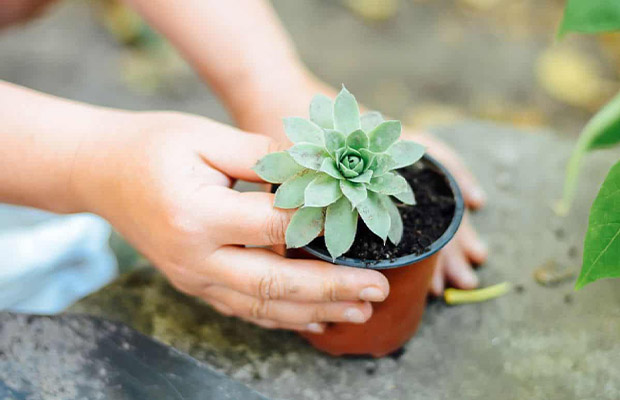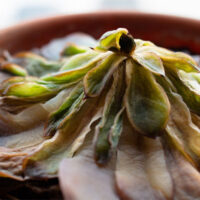Concerned about fertilizer for succulents? A common misconception is that succulents don’t require fertilizer. But succulents will gain from routine fertilizing just like the majority of plants.
The ideal characteristics of a healthy succulent are thick, supple, and firm leaves. Your succulents’ growth will be aided by regular watering and protection from excessive sunlight. The ultimate aim should be to keep it thriving. It helps if you feed your succulent with the best succulent fertilizers to accomplish that.
The best times to fertilize for succulents are in spring when daytime temps stay above 60 degrees F; and in the fall, right before a rainstorm. Note: Growers fertilize plants more often to promote faster growth
Find out what to use and how frequently you should fertilize!
Table of Contents
What Do I Use To Fertilize?
Succulents grow lush and beautiful with a light feeding of manure tea, diluted fish emulsion, or a balanced fertilizer (15-15-15). Liquid fertilizers that are concentrated should be diluted. Roots could be harmed if this is not done.
For container-grown succulents, use three gallons of water with one Moo Poo tea bag steeped overnight. Pour until it drips out the bottom starting at the plant’s base. Use fish emulsion instead, but dilute it by half.
In-ground succulents don’t really need fertilizing, but to boost lush spring growth, apply Before a winter storm, and use ironite as directed on the package. Apply a balanced granular fertilizer in the spring (if you choose to; it is not required).
How To Fertilize Succulents?
- Use half the recommended amount of fertilizer for most succulents by dissolving a low-balanced soluble fertilizer in one gallon of water, such as an 8-8-8 or 10-10-10 formula. Use ½ tablespoon of 10-10-10 fertilizer, for instance, if the label instructs you to use 1 tablespoon per gallon of water. For tropical succulents that need to be watered more frequently, like a Christmas cactus (Schlumbergera bridgesii), dilute to one-fourth strength.
- When the excess moisture is just starting to drain from the pot bottom, water succulents with the half-strength solution. Depending on the size, a gallon of fertilizer solution might be sufficient to feed several plants. Apply the fertilizer twice, once in late summer or early fall and once in the spring when new growth starts. When succulents are semi-dormant in the winter, avoid fertilizing them.
- During the active growing season of the plant, water tropical succulents once a week with the quarter-strength solution. While some tropical species are summer plants, others are active growers in the winter. In the event, that plant growth naturally slows, stop applying fertilizer.
- Once the soil in the pot’s top inch has completely dried, fertilizers should be applied. If the soil is still wet, put off applying it every week until it has had time to dry.

When To Fertilize Succulents?
When fertilizing succulents, timing is crucial. This activity cannot be done in all seasons. The majority of succulents are dormant in the winter, so fertilizing during this time won’t produce any results. Spring is the best season to do it. The best time to use the technique is when the daytime temperature reaches 15 degrees Celsius ( 59 degrees Fahrenheit).
For liquid fertilizers, you should only use half of the recommended dosage. If you use pellets of fertilizer for succulents, spread them out evenly in small amounts before giving your plants plenty of water. Succulent burns can be caused by using an excessive amount of pellets or diluted fertilizer. Once a year, in the spring, it is advised to fertilize succulent plants. Utilizing organic fertilizers like manure tea, you can do that on a monthly or quarterly basis.
How Often To Fertilize Succulents?
You might be wondering how frequently to fertilize succulents is now that you are aware of a fantastic fertilizer. Succulents can be fertilized as frequently as once per month, especially if you use manure tea, but they will usually thrive with just one spring fertilization per year.
Many succulents are starting to grow now, so they are prepared to use the extra nutrients. I would advise fertilizing in the fall if you have mostly succulents that grow in the winter.
Avoid slow-release fertilizers if you choose to use something other than manure tea for your succulents. These are very strong and frequently cause the succulents to burn rather than grow. It is best to use a water-soluble fertilizer that has been diluted to half the recommended strength.
Fertilizing Indoor Succulents
Whether indoor succulents require fertilizer is a subject I have debated. In the end, I’ve chosen to fertilize mine only once a year, in the spring (as the days lengthen).
If your succulents aren’t getting enough light, the fertilizer can make them grow so quickly that they stretch a lot.
If you can, move your succulents outside right after fertilizing to a sunny, shaded spot to keep them compact while they enjoy the nutrient boost. If you decide to keep them indoors, make sure they have as much light as you can provide. You might even want to use a grow light.
Related Reading: How to Care for Outdoor Succulents?
Some Alternative Fertilizer Options
It is possible to use other organic materials as fertilizer. Eggshells can be used in a variety of ways, such as crumbled up or in tea.
After rinsing the shells to remove any remaining yolk or white, cover them with boiling water. The next morning, strain the shells out after letting them soak all night. Pour the “eggshell tea” on your succulents to give them an added calcium boost. This may also provide them with additional potassium, but it is deficient in nitrogen, a necessary element for succulents, so you might need to use another fertilizer that does.
Final Words
If the soil in the pot is drying out quickly and needs to be watered more frequently for most succulents, you can substitute the quarter-strength fertilizer. Before the plant can access the nutrients, frequent irrigation flushes them from the pot.
Due to their ability to access the soil’s nutrient store, outdoor succulents typically don’t need fertilizer. Apply a balanced, slow-release fertilizer in the spring in half the recommended amount if they do require feeding.
Read More: How Often & How to Water Succulents?

















